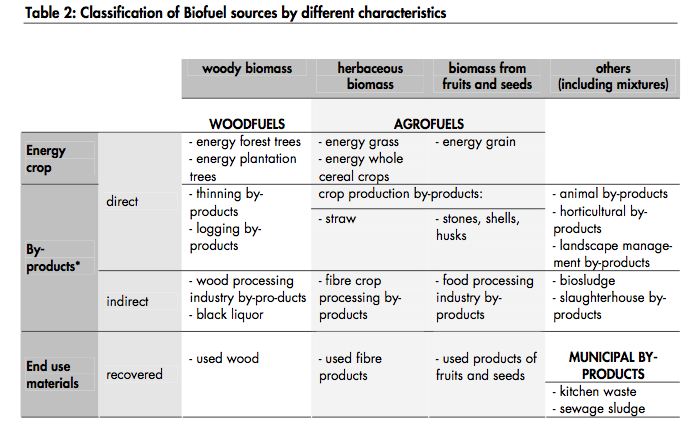Difference between revisions of "Biofuels"
***** (***** | *****) |
***** (***** | *****) |
||
| Line 1: | Line 1: | ||
| + | |||
= Introduction = | = Introduction = | ||
| − | < | + | <span style="line-height: 1.5em; font-size: 0.85em;">Biofuels are liquid or gaseous fuels produced from biomass that are generally high in sugar (such as sugarcane , sugarbeet , sweet sorghum) , starch (such as corn and cassava) or oils (such as soybeans, rapeseed, coconut, sunflowers, and palms).<ref>http://biofuelsandthepoor.com/facts-and-definitions/</ref> </span><span style="color: rgb(21, 21, 21); font-family: 'Lucida Sans Unicode', 'Lucida Grande', 'Lucida Sans', Arial, sans-serif; font-size: 13px; line-height: 19.200000762939453px;">The two most commonly used biofuels are ethanol and biodiesel.<ref>http://www.nrel.gov/learning/re_biofuels.html</ref></span> |
| + | |||
| + | . | ||
== Classification of Biofuel Sources == | == Classification of Biofuel Sources == | ||
| − | Classification of Biofuel sources according to Food and Agricultural Organization (FAO)<ref name="Unified Bioenergy Terminology ftp://ftp.fao.org/docrep/fao/007/j4504e/j4504e00.pdf, page 9">Unified Bioenergy Terminology ftp://ftp.fao.org/docrep/fao/007/j4504e/j4504e00.pdf, page 9</ref>. | + | == Classification of Biofuel sources according to Food and Agricultural Organization (FAO)<ref name="Unified Bioenergy Terminology ftp://ftp.fao.org/docrep/fao/007/j4504e/j4504e00.pdf, page 9">Unified Bioenergy Terminology ftp://ftp.fao.org/docrep/fao/007/j4504e/j4504e00.pdf, page 9</ref>. == |
[[File:FAO Classification Biofuel sources page9.png|695px|RTENOTITLE]]<br/> | [[File:FAO Classification Biofuel sources page9.png|695px|RTENOTITLE]]<br/> | ||
| + | |||
| + | *<span style="font-size: 0.85em;">*The term “by-products” includes the improperly called solid, liquid and gaseous residues and wastes derived from</span> | ||
| + | <div>biomass processing activities. </div> | ||
| + | == Classification of biofuel according to generations == | ||
| + | |||
| + | Biofuels are generally classified as first , second and third generations: | ||
| + | |||
| + | First-generation biofuels are made from sugar, starch, vegetable oil, or animal fats using conventional technology. These are generally produced from grains high in sugar or starch fermented into bioethanol; or seeds that which are pressed into vegetable oil used in biodiesel. Common first-generation biofuels include vegetable oils, biodiesel, bioalcohols, biogas, solid biofuels, syngas. | ||
| + | |||
| + | Second-generation biofuels are produced from non-food crops, such as cellulosic biofuels and waste biomass (stalks of wheat and corn, and wood). Common second-generation biofuels include vegetable oils, biodiesel, bioalcohols, biogas, solid biofuels, and syngas. Research continues on second-generation biofuels including biohydrogen, biomethanol, DMF, Bio-DME, Fischer-Tropsch diesel, biohydrogen diesel, mixed alcohols and wood diesel. | ||
| + | |||
| + | Third-generation biofuels are produced from extracting oil of algae – sometimes referred to as “oilgae”. Its production is supposed to be low cost and high-yielding – giving up to nearly 30 times the energy per unit area as can be realized from current, conventional ‘first-generation’ biofuel feedstocks.<ref>http://biofuelsandthepoor.com/facts-and-definitions/</ref> | ||
<br/> | <br/> | ||
| − | == | + | == <br/> == |
| + | |||
| + | == <br/> == | ||
| + | |||
| + | <br/> | ||
| − | == | + | == <br/> == |
Revision as of 11:23, 4 March 2014
Introduction
Biofuels are liquid or gaseous fuels produced from biomass that are generally high in sugar (such as sugarcane , sugarbeet , sweet sorghum) , starch (such as corn and cassava) or oils (such as soybeans, rapeseed, coconut, sunflowers, and palms).[1] The two most commonly used biofuels are ethanol and biodiesel.[2]
.
Classification of Biofuel Sources
Classification of Biofuel sources according to Food and Agricultural Organization (FAO)[3].
- *The term “by-products” includes the improperly called solid, liquid and gaseous residues and wastes derived from
Classification of biofuel according to generations
Biofuels are generally classified as first , second and third generations:
First-generation biofuels are made from sugar, starch, vegetable oil, or animal fats using conventional technology. These are generally produced from grains high in sugar or starch fermented into bioethanol; or seeds that which are pressed into vegetable oil used in biodiesel. Common first-generation biofuels include vegetable oils, biodiesel, bioalcohols, biogas, solid biofuels, syngas.
Second-generation biofuels are produced from non-food crops, such as cellulosic biofuels and waste biomass (stalks of wheat and corn, and wood). Common second-generation biofuels include vegetable oils, biodiesel, bioalcohols, biogas, solid biofuels, and syngas. Research continues on second-generation biofuels including biohydrogen, biomethanol, DMF, Bio-DME, Fischer-Tropsch diesel, biohydrogen diesel, mixed alcohols and wood diesel.
Third-generation biofuels are produced from extracting oil of algae – sometimes referred to as “oilgae”. Its production is supposed to be low cost and high-yielding – giving up to nearly 30 times the energy per unit area as can be realized from current, conventional ‘first-generation’ biofuel feedstocks.[4]




















